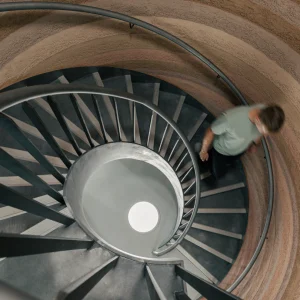
And yet topped with a massive stone globe, the Radcliffe Observatory nevertheless stands out, albeit overlooked by the camera-laden hordes. Dominating its site, the octagonal building unambiguously projects its scientific function and serves as a lasting reminder of the centrality of astronomy in the history of science.
The observatory, in its function as the platform of recording astronomical phenomena, is thus an essential backdrop for Simon Starling’s film. Black Drop uses the transit of Venus as a starting point from which Starling is able to unpack the deep-seated influences that scientific observation has had on modern thought. In particular, the film explores how the transit of Venus has been crucial to the history of the recorded image. In fact, Starling states that Black Drop is as much about the history of cinema as it is about the history of the transit of Venus.
Black Drop focuses on the historical efforts to accurately record the transit of Venus in order to determine the distance between the Earth and the Sun. Scientific observers in 1771 were frustrated by the eponymous ‘black drop effect,’ or visual distortions to the perceived shape of the planet as it touches the edge of the sun’s outline, making accurate recording impossible. The 18th century drawings produced by these observers depict a frame-by-frame movement of Venus and the effects of its visual distortions. Over a hundred years later, this strategy was taken up in 1874 by French astronomer Jules Janssen, but with the incorporation of the new technology of photography. Janssen developed a method of documentation that used a continuous frame-by-frame spool to precisely measure the transit, thus inadvertently creating one of the earliest cinematographic cameras.
Black Drop chronicles both this history as well as Starling’s own travels to Tahiti and Hawaii in 2012 for the purpose of similarly documenting the transit. Since this astronomical event will not occur again until 2117, Starling explicitly chose to use 35mm film in order to record the event, as it is likely the last time that this event will be recorded on film. Starling thus consciously inserts his own film into the history of the moving image, and becomes a part of the history that the film itself documents.
The 2005 Turner Prize winner’s work revolves around what he describes as the "questioning the making of things," combing out narratives from the craft of material objects. A 2005 piece, Shedboatshed (Mobile Architecture No. 2), for instance, deconstructed a shed on the banks of the Rhine, used its timber to construct a small boat, which was then used to transport the remaining parts of the shed to a museum in Basel. The shed was then reconstructed in the gallery space, bearing the scars of its transformation.
Yet as opposed to some of the artist’s earlier works, Black Drop is successful as it is able to negotiate the processes that have resulted in the singular production of a given object in space, time, and memory through an intelligent application of Starling’s own craft as an inextricable part of these productive narratives. But whereas Starling’s other work often verges on what can seem like pointless intellectual vanity wrapped around a circular narrative of making, Black Drop is able to avoid this pitfall by benefiting from a more mature relationship to the practice of history.
It operates by inserting itself into the narrative of filmmaking, and in so doing transforms it through providing a genuinely new chapter of its history. In Starling’s practice, the artwork thus evolves the fascinating role of not only documenting history, but also of positioning this documentation historically. As such, Black Drop is a challenging and bold piece of work as it asserts that the crafted object is capable of providing legitimate and novel contributions to historical knowledge.
Simon Starling’s 2013 Black Drop, is shown every Sunday and Monday between February 24 and March 24, in the Radcliffe Observatory, Green Templeton College, Oxford. The film was produced in coordination between Modern Art Oxford and the University of Oxford.
Simon Starling’s Black Drop: Making History, Documenting History
Radcliffe Observatory, Oxford
Until March 24
Daniel Ayat





